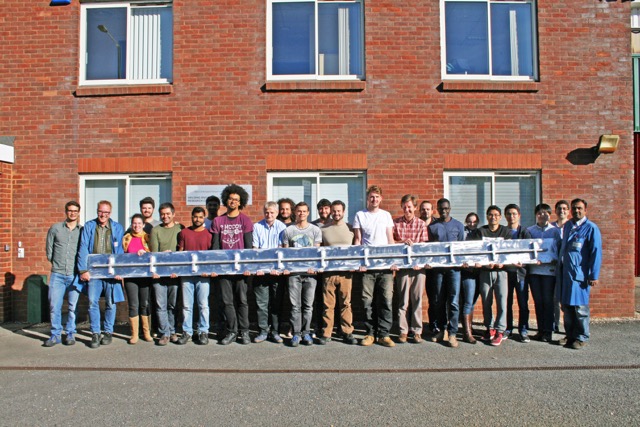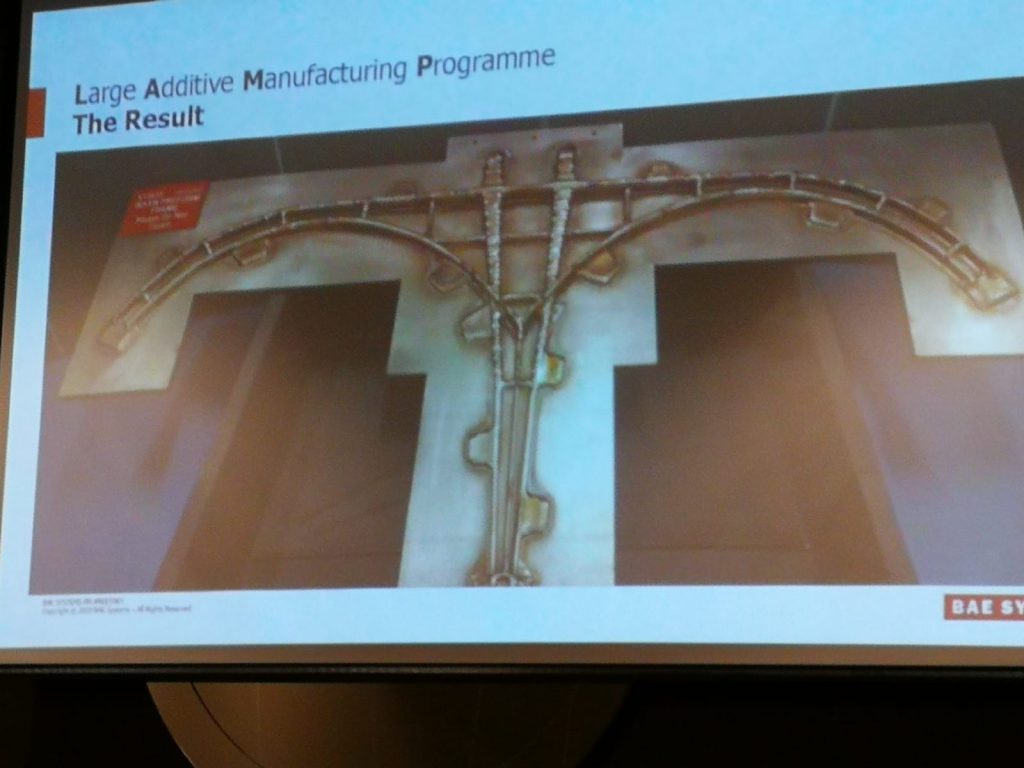Cranfield University and spinout company WAAM3D have unveiled two of the most high profile parts they have ever developed using wire arc additive manufacturing (WAAM) technology. The first, the rear frame for a Eurofighter Typhoon aircraft, was produced for British defense company BAE Systems and unveiled at the 2019 Additive Manufacturing in Space and Aerospace Conference. The second, is a prototype pressure vessel developed in collaboration with a Franco-Italian aerospace manufacturer Thales Alenia Space and Cranfield’s fellow WAAM developer Glenalmond Technologies.
Both parts present a crucial step forward for WAAM3D’s pursuit of this technology’s commercialization. WAAM3D CEO Dr. Filomeno Martina, who is also a Senior Lecturer at Cranfield, comments, “We are very proud of the level of automation achieved at Cranfield University.” Speaking of current WAAM hardware and software development, Dr. Martina adds:
“WAAM3D will make all these tools available to industrial community in the next couple of months and we are looking forward to the impact on industrial large-scale additive manufacture this will have.”
Commercialization of WAAM technology
WAAM3D was founded in 2018 for the purpose of commercializing all the elements needed for applying WAAM technology within engineering industries. This encompasses all parts of the trifecta – specialist CAM software, machinery, materials – and even support and training platforms to secure adoption and the technology’s usage throughout an organization. The company is a spin-out of Cornfield University’s WAAMMat program, which seeks to increase the maturity of the WAAM process in collaboration with industry partners such as BAE Systems and Thales Alenia Space.

In 2014, WAAMat’s development work was showcased in the production of an impressive 1.2 meter long spar part. Since then, however, work on the project has remained largely undisclosed, apart from a relocation within Cranfield’s £35 million Aerospace Integration Research Centre (AIRC).
In our most recent update with Dr. Martina, he described the two newly presented parts as the “most important results” of the WAAMat program from the past year. “All these parts have been programmed and built with a new CAM software developed by ourselves,” he added, “The main point is the automation in the generation of the tool-path, and the automatic calculation of all process parameters, which are also varying around the tool-path itself to achieve 100% density, no defects, and the right geometry as per CAD file.”
“This is unheard of in the field of large-scale AM, and it’s the key element needed for a quick industrial pick-up.”
The high profile aerospace parts
BAE Systems’ Eurofighter Typhoon part is made from Ti-6Al-4V and measures 2.5m x 1.5 m in planar area. It is built of 200 layers, each programmed with 7,000 tool path points. As a rear frame for the aircraft, this part is built to support the dual Eurojet EJ200 engines capable of producing 60 kN (13,500 lbf) of dry thrust. Further, according to WAAMat the “Fatigue properties [of the part are] equal to or better than current forgings. No distortion. Local shielding only.”

Also made from Ti-6Al-4V alloy, Thales Alenia Space’s pressure vessel is approximately 1 m tall, and weights 5.5 kg. By applying WAAM to the production of this piece, the collective saves more than 200kg of material per item, and also consolidates two parts into one. It was fabricated by WAAM3D in a matter of days, significantly cutting lead times for the part which typically runs into several months.
Eng. Massimo Chiampi, Study Manager for Additive Manufacturing projects at Thales Alenia Space, comments, “We were looking for an innovative manufacturing solution for the tanks, which typically suffer from long lead time with the conventional production route based on subtractive machining. Thanks to this project, we have demonstrated that the adoption of WAAM technology enhances the competitiveness of our product.”

In addition, Chiampi says, “We have achieved a 65% reduction on the overall lead time without giving up the requested performances and this provides a benefit also in terms of design flexibility, making it possible to answer customer needs at a late stage of the project.”
The first commercial products from WAAM3D are expected for release throughout 2019, with its CAM software solution expected to enter the market in April.
Dr. Jialuo Ding, Principal Research Fellow at Cranfield University and Chief Scientist at WAAM3D, concludes, “We have been developing WAAM technology for more than 10 years and it is very satisfying to see it reach this level of commercial maturity.”
“We are very excited about rolling out the technology through our new spinout company, WAAM3D.”
For regular additive manufacturing aerospace news updates subscribe to our newsletter, follow us on Twitter and like us on Facebook. Visit 3D Printing Jobs for new additive manufacturing opportunities in your area.
Featured image shows a Eurofighter Typhoon aircraft (engines visible) the recipient of a WAAM 3D printed rear frame. Photo via BAE Systems



